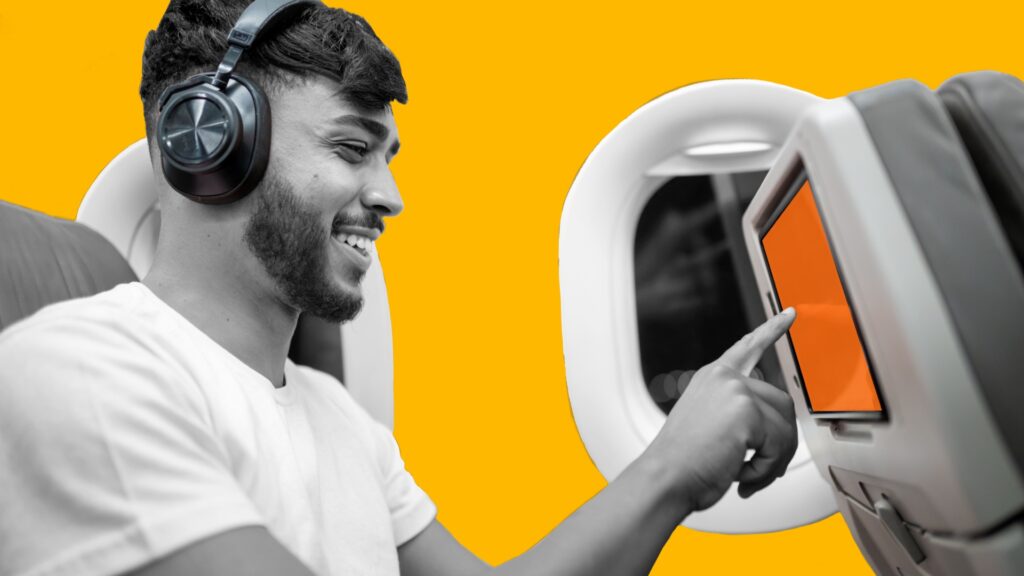The Future of (C)TV Is Now
by Jaci Schreckengost
4 Min Read
CES 2024: Stagwell (STGW) and MNTN Announce Partnership in Unified Performance SolutionsLearn More
Major airlines ink deals to bring streaming to the friendly skies

3 Min Read
In the 1920s the first in-flight movie was shown to 11 passengers via a projector. In the 1950s, airlines started to offer in-flight drinks. The ‘90s saw the rise of LCD screens installed to the back of first-class seats, and the ‘00s gave us in-flight Wi-Fi. Today, a new entertainment option is keeping passengers occupied on long fights: Connected TV.
During the pandemic, Connected TV rose to new heights as more viewers than ever streamed their favorite shows and movies. Now that the world has opened back up, people are not cutting loose—they’re just finding new ways to bring their content with them. Whether it’s watching on the phone or bringing a streaming stick to the hotel, viewers are consuming more content than ever while they’re out and about—and now they’re watching on flights. This is great news for the airlines, passengers, streaming services—and yes, even advertisers – as more consumers get immersed in the CTV ecosystem.
While many airlines have their own in-flight entertainment, including their own streaming services, some of the biggest airlines have taken a step further and embraced major streaming services—and their original content slate. In 2019, Delta Airlines inked a deal to bring hit Hulu shows like The Handmaid’s Tale and The Mindy Project to their flights—programming that has been some of the highest performing content chosen by passengers. Delta also made deals with Showtime and HBO Max to stream selected episodes of hit shows.
Meanwhile, competing airline American Airlines made deals with Showtime, HBO Max, AppleTV+ and—just recently—added NBCUniversal’s Peacock and its original programming. These moves are signaling the next step of in-flight entertainment, as airlines make deals to leverage popular streaming services and their expensive, hit programming. All of this is done without having to make individual deals for movies and shows themselves, and airlines get the added benefit of popular, premium, exclusive content.
The partnerships to bring CTV to the skies are a rare business deal that benefits everyone. Airlines get to have access to exclusive programming and make their flights more enjoyable. Customers get to have access to more programming to keep them entertained on long flights. And streaming services—finding themselves in a more competitive market than ever before—can give potential customers a hands-on test drive of their platform and exclusive content. Better yet, this preview is being given to an audience with few other distractions and nowhere else to go.
For that reason, it’s no wonder that streaming services are bullish on signing deals with airlines. And as more services enter the market and consumers face creeping subscription fatigue, in-flight entertainment might be the best opportunity to hook viewers—and get them to subscribe after landing. As American Airlines’ manager of onboard products, Meghan Lemeke, told Marketing Brew, “It’s one of those things that is truly a benefit for both American [Airlines] and for our partners because we’re bringing something to the customer that we know that they want, and hopefully, that turns into a subscriber for these partners long-term.”
While most in-flight entertainment is currently ad-free, and none of it has the targeted ads that CTV is known for, advertisers still stand to benefit from viewers getting hooked and subscribing to new services—where they’ll continue watching from their living room. According to Lemeke, “These partners that we work with are hoping to get more eyeballs on their content and to just reach people that maybe aren’t subscribing today.”
And as both Connected TV advertising and in-flight entertainment continue to innovate and expand, it seems inevitable that targeted ads will follow the viewer on their flight—and offer suggestions based on where they’ll be landing, like a restaurant or entertainment venue. But just like that tiny projector that wowed less than a dozen people on a tiny plane over 100 years ago, for in-flight TV the sky’s the limit—and we’ll surely be amazed at where it goes next.